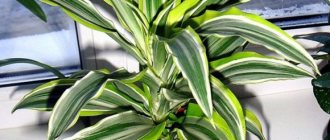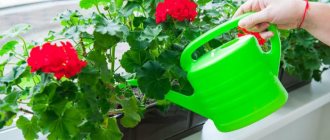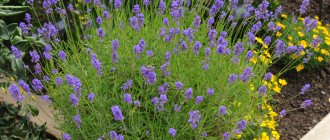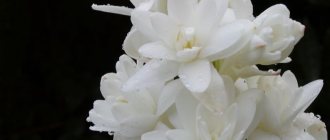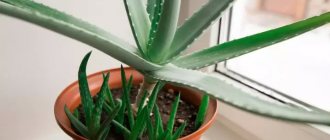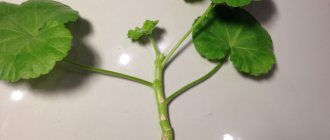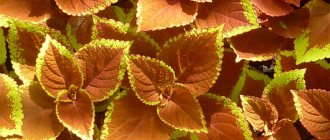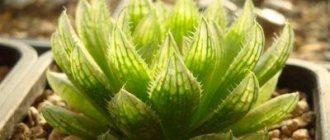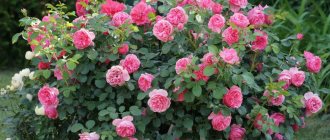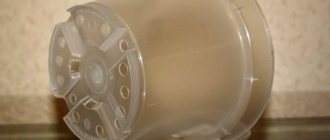When and how to plant petunia in pots outside?
Initially, you need to prepare the pots and sow the seeds. This is done at the end of February. It is necessary to mix the seeds with wet sand and place them on the ground. After this, the containers are covered with glass caps and wait for the sprouts to appear.
After this, the sprouts are thinned out; it is necessary that the distance between the sprouts be 5 cm. Next, you can sprinkle with a layer of damp soil. Water the plants from time to time and after a month you can replant them in pots. Containers with turf soil are suitable for this. Many gardeners recommend mixing hydrogel. This is silica gel that is pre-soaked in water. Introduce into the pot in a ratio of 1:5 with soil. This mixture retains moisture well and prevents root rot.
Planting instructions:
- Do not immediately take the plant outside. At the end of April and in May, night frosts are still possible. That is why flowers are gradually accustomed to lower temperatures.
- Maintain the temperature at +18 °C all week. Next, reduce to +15 °C. After this, place the plant on the balcony and monitor the temperature.
- Once the threat of frost has passed, you can move the plants outside or into the yard.
Planting in open ground is carried out on a cloudy day or after sunset. When exposed to direct sunlight, the leaves wither and the plant does not take root well.
When and how to plant petunia in pots outside?
Features of flower care
Flowers planted in pots must be carefully looked after, since they grow in a small amount of substrate. Therefore, you will need to monitor flowering, as well as remove seed boxes and dried buds in a timely manner.
At the height of the summer season, cascading and ampelous varieties are capable of stretching lashes, which will interfere with the plant’s ability to bloom normally. Then you will need to cut off the excess length of the shoots. Let's look at all the features of flower care.
Watering
If the pot with the plant is placed under a canopy or in a closed room, the flower should be moistened more often, especially on hot summer days. Spraying must be done every day. If the weather is cloudy outside, water the plant when the substrate in the pot dries.
Clue! The drainage layer should be inspected during the season. Moisture should not stagnate in the pots for a long time, otherwise the roots of the plant may rot.
In addition to moisturizing, you also need to spray the foliage with warm water. This will ensure the flow of moisture not only to the root system, but also to all parts of the plant.
Spraying helps prevent the development of spider mites on flowers. Irrigation should be carried out either in the morning or in the evening when the sun is not shining, otherwise the plant will get burned.
Top dressing
After 14 days from the moment the flowers are planted in the pots, the plant should be fertilized for the first time with preparations that contain nitrogen. When buds begin to form, petunias require phosphorus-potassium fertilizers.
If the foliage on the plant begins to turn yellow or dry out, it means the crop lacks iron. To restore the balance of the microelement, you will need to fertilize the petunia with iron chelate. The procedure is carried out 4 times every seven days.
What pots are best to plant petunias in?
The flowerpot is selected depending on your preferences. This is the basket in which the pot is placed. The basket itself is suspended and the flowers fall down. It is worth noting that you should not choose small flower pots, as there will not be enough space for the development of the root system. On average, pots with a diameter of 22 cm and a volume of 5 liters are chosen. This is enough for one plant.
What pots are best to plant petunias in?
Landing rules
You can use any boxes for planting seeds. It is also important to choose the right soil for petunia.
What kind of soil do petunias like:
- the soil must be moisture-absorbing;
- the soil for petunia should be loose;
- the acidity level should be between 5.5-5.7 pH. You need to measure the acidity in advance, before planting the seeds. To measure it, gardening stores sell special devices;
- the soil should be rich in nutrients.
You can buy soil at the store or make it yourself.
Substrate composition:
- coconut fiber;
- universal primer;
- agroperlite;
- wood ash.
If you use soil from your summer cottage, then before planting it needs to be treated, for example, you can pour boiling water on it and cover it with cling film. When the earth has cooled, repeat the procedure. You can also water the soil with a solution of potassium permanganate.
How to grow ampelous petunia:
- Flower propagation occurs mainly by seed. Fill the bottom of the box with drainage, then soil.
- Sow the seeds and lightly sprinkle them with soil.
- Water the soil.
- Cover the box with cling film and place it on a south window.
- When sprouts appear, remove the film.
- Picking is carried out after a pair of full leaves appears on each bush.
For your information! It is better to plant seedlings in peat pots and then plant them in the ground together.
The best varieties of petunias for hanging flowerpots: list, names
Not all varieties are suitable for planting in pots. The pot itself implies that the plant will droop. Often such petunias are planted near arbors, and over time they entwine it. Arches braided with petunias look very nice. Ampelous petunias are chosen for growing in pots and flowerpots. They cascade down and have beautiful flowers.
The most popular varieties:
- Surfinia
- Pirate
- Rendula
- Avalanche
Please note that if you are planting flowers outside, you should limit watering and adjust for natural precipitation. If under a canopy, the plant needs daily watering.
The best varieties of petunias for hanging flowerpots: list, names
How to choose a hanging container?
A flowerpot is a vessel in which a flower pot is placed ; it has a largely decorative function, while the pot has a utilitarian function.
Initially, flowerpots were intended to hide nondescript clay pots to add decorativeness to a room or setting. Thus, the flowerpot serves as a tray, but increasingly, plants are planted directly in the flowerpot without using a pot. On the modern market, flower pots are presented in a wide variety of materials, designs, and colors. So how do you choose? First of all, one should proceed from a practical point of view. If we are talking about ampelous petunia, then it is mainly planted on verandas, gazebos, balconies, around the house, that is, open areas and rooms. Therefore, it is necessary to choose a material that will not deteriorate from rain, wind and sun. In this case, plastic, ceramics and metal are suitable.
Hanging pots are most suitable for hanging petunias. Here are some popular varieties :
- Flowerpot on a metal chain with a cocovita liner.
- Plant pots made of plastic with imitation rattan.
- A simple plastic planter.
- Flowerpots with fastenings for balconies and hedges.
The advantages of hanging flower pots include the following characteristics::
- save horizontal space;
- can be placed where there is no support;
- high mobility, for example, during frosts you can easily bring it into a warm room.
Also similar in their characteristics to hanging ones are wall vases, which can perfectly decorate the walls of your gazebo or terrace.
An interesting type of flowerpot is in the form of a floor vase, in which hanging plants will fall in a beautiful waterfall all the way to the ground. Such a vase can be made of plastic or ceramic.
You can build a tall vase from several larger, flatter vases; if you place one on top of the other, then your garden will have a kind of fountain of flowers.
Otherwise, when choosing a flowerpot, a gardener should be guided by his taste preferences and the general style of the house , so that the flowerpots are combined with each other and with the surrounding environment, then the flowers will decorate the space and look harmonious.
Ampelous petunia: how many seedlings should be planted in a pot and at what distance from each other?
You can plant 2 petunias in a 10 liter pot. These plants have roots that grow well; they may not have enough space in the future. One plant should be planted in a small 5 liter pot.
It is worth understanding that such plants should be trimmed in time and dried flowers removed. Otherwise, the plant will begin to wither. In addition, the number of flowers may be reduced. As soon as you notice that the leaves and flowers are withering, cut off ¼ of the branches.
Ampelous petunia: how many seedlings should be planted in a pot and at what distance from each other?
Formation of petunia - summer haircuts for future beauty
By mid-summer, petunias usually begin to bloom worse, the vines become longer, and the flowers become smaller. In order to return the plants to their decorative appearance, they are pruned. Bush petunias can be trimmed radically, leaving 10-12 cm. Trimming the ampels is not so radical - the lashes are shortened by about half their length.
This petunia was pruned almost to a stump 2 weeks ago! And now it’s already blooming!
Don't be afraid to prune petunias, don't spare them! You will see, the branches and leaves will grow quite quickly and in just 2 weeks, instead of the aging frail “freak”, you will get a young magnificent bush of lush greenery and flowers. During this period, it is very important to fertilize petunia correctly and regularly. Then she will tolerate pruning very easily and will respond to it with the rapid growth of new branches and abundant flowering.
Petunias can be trimmed several times a season, usually done in mid-summer (July) and early autumn (September).
Bush petunia: how many seedlings should I plant in a pot and at what distance from each other?
In general, this species is not grown in pots. Such plants are planted in the country, directly on open ground. The approximate distance between seedlings should be 20 cm. Accordingly, when growing this species in pots, one bush per container with a diameter of 20-30 cm is enough.
Bush petunia: how many seedlings should I plant in a pot and at what distance from each other?
All four sides of the world...
Important conditions for growing petunias are light and air. Moreover, these two components are equally important. Petunia will wither in deep shade (for example, on a balcony darkened by trees), as well as on a light but glazed loggia, where there is little fresh air flow.
Petunia loves open and sunny balconies facing south and southeast, where it will bloom especially luxuriantly. However, modern varieties of petunias (for example, supertunia, minitunia, fortunia) also perform well on the north side, being planted in balcony boxes. Therefore, if you have a northern balcony, never choose simple petunias for it, they will stretch and bloom sparingly, only expensive seeds of modern hybrids will save you. Do not spare money - luxurious flowers are worth it!
Supertunia can look wonderful even on a northern balcony, provided it is properly cared for
Pot diameter 20 cm: how many petunias should I plant?
You should plant no more than two shoots in a large pot. In a pot with a diameter of 20 cm, it is enough to plant just one sprout. If you think that with a large number of sprouts you will get a lush bush, then you are mistaken. The roots of the plants will interfere with each other. Therefore, the optimal quantity is one bush. With proper care it will grow well and be lush.
Pot diameter 20 cm: how many petunias should I plant?
Petunia diseases - what can overshadow the lush flowering?
Petunia is not a capricious plant, but it can also be damaged by a number of diseases. The most common disease that petunia bushes typically encounter each summer is powdery mildew. A powdery white coating appears on the lower leaves, smelling like mushrooms (which is not surprising, since powdery mildew is caused by a fungus). The leaves themselves turn yellow, lose turgor and hang like lifeless rags. Getting rid of powdery mildew is quite simple if you use antifungal drugs (Fundazol, Emerald, Topaz, etc.).
Sometimes suspicious midges begin to hover over the petunia. Most often this is a whitefly, to destroy which you can use any insecticide, for example “Aktara” or the more armor-piercing “Aktellik” and “Fitoverm”. You can also destroy a close relative of the whitefly - aphids.
Well, the worst thing that can end up on a petunia is a spider mite. A small arachnid settles on the lower part of the leaf blades and begins to suck out the juice, systematically leading the plant to death. To destroy the pest, you should use acaricides - “Fitoverm”, “Aktellik”, etc.
Sometimes adult petunia turns yellow. This can happen due to disturbed temperature conditions, the presence of harmful “living creatures” or chlorosis – a lack of iron. Chlorosis occurs due to disturbances in the vital functions of the plant, which ceases to absorb iron in the required amount. A similar disease is treated by spraying the plant and watering the soil with various iron-containing preparations - “Ferrovit”, “Micro Fe”, etc.

